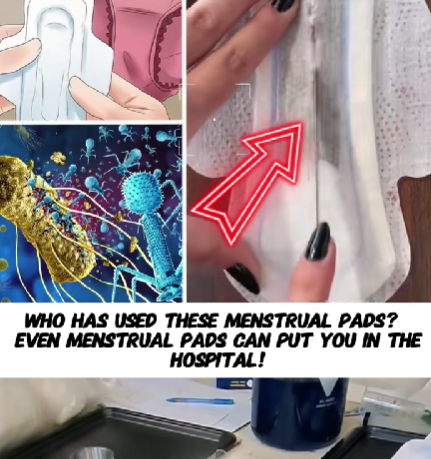A recent wave of online concern has erupted after viral videos claimed that certain menstrual pads might contain harmful substances capable of causing serious health issues. While not all of these claims are fully verified, experts say the conversation highlights a critical and often-overlooked topic: the safety of feminine hygiene products and the chemicals used in their production.
The alarming footage circulating online shows users cutting open popular pad brands and revealing unexpected materials—fibers, powders, and residues that some say could trigger irritation, infections, or even hospitalization. The clips quickly sparked global outrage, especially among women who’ve long experienced unexplained discomfort during their menstrual cycles but were unsure of the cause.
According to health experts, while the majority of pads on the market are regulated and tested for safety, certain cheaper or counterfeit products—especially those sold online without certification—can pose real risks. These unsafe versions might be made with low-quality materials, chemical adhesives, or artificial fragrances that can disrupt the body’s natural balance and lead to conditions like toxic shock syndrome (TSS), severe rashes, and allergic reactions.
Dr. Melissa Ortega, a gynecologist specializing in women’s health safety, explains, “It’s not the product itself that’s dangerous—it’s the lack of transparency about what’s inside. Some pads may contain bleaching agents or plasticizers that can irritate sensitive skin or trap moisture, allowing bacteria to grow.”
Indeed, tests conducted by independent watchdog groups in several countries have revealed traces of dioxins, synthetic perfumes, and formaldehyde in a handful of low-quality sanitary products. While exposure levels are typically small, long-term or repeated contact—especially in non-breathable products—can increase health risks.
The viral posts have also reignited calls for clearer labeling standards. In many countries, menstrual products are still classified as “medical devices,” meaning companies aren’t required to list every material or chemical used. Activists argue that this loophole leaves consumers vulnerable. “Women deserve to know what they’re putting on their bodies,” says campaigner Ana Torres. “We read food labels every day—why not hygiene products too?”
In response to the online panic, several major brands have issued statements assuring users that their products are safe, dermatologist-tested, and free from toxic additives. Still, gynecologists recommend taking precautions:
- Buy only from reputable sources. Avoid unbranded or suspiciously cheap options online.
- Choose pads labeled hypoallergenic or fragrance-free.
- Change frequently. Never wear a single pad for more than 4–6 hours.
- Watch for warning signs. Redness, itching, or fever could signal infection or allergic reaction—seek medical advice immediately.
While the internet may exaggerate some of these claims, the takeaway remains important: menstrual health deserves transparency, research, and education. What women use every month shouldn’t be a mystery.
This viral moment has done more than just spark fear—it’s fueling a growing movement demanding that feminine hygiene companies take full accountability for product safety. Because when it comes to health, no woman should have to wonder if the products meant to protect her might be putting her at risk.
